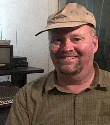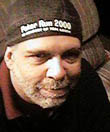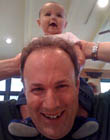|
|
This topic comprises 2 pages: 1 2
|
|
Author
|
Topic: The Glory of 70mm
|
Ed Johnson
Film Handler
Posts: 24
From: Lancaster, MA/Appleton, WI
Registered: Jul 99
|
 posted 11-07-1999 01:02 AM
posted 11-07-1999 01:02 AM




Ok, I've been thinking about this one for a while. Every once and a while the topic of 70mm comes up on this forum and it is treated as a great, if lost, format. Unfortunately, all of the talk of 70mm is in the past-tense. It sounds like Hollywood has completely lost interest in the format. Is this a financial thing or is it rationalized by saying that modern emulsions have improved 35mm to a point that the difference between formats would not be appreciable? Growing up in the late '80s and early '90s, I've never seen a film presented in 70mm. The 15-plex where I worked for the last year was equipped for 70mm projection (supposedly) but in the three years since the theater opened, I don't believe anything has been released in the format. What was the last new movie filmed and released in 70mm (I don't count something like the 3 or 4 70mm prints of Titanic)? Is there any indication that future movies may utilize the format? I suppose many new releases have so much computer "enhancement" that the increased resolution would be appreciated... I'm interested in your opinions.
------------------
Ed Johnson
Lawrence University
Appleton, WI
| IP: Logged
|
|
|
|
|
|
|
|
|
|
|
|
|
|
|
|
|
|
|
|
|
|
John Walsh
Film God

Posts: 2490
From: Connecticut, USA, Earth, Milky Way
Registered: Oct 1999
|
 posted 11-08-1999 09:45 AM
posted 11-08-1999 09:45 AM




There are generally two types of 70mm. One is where the original negitive in the camera is 35mm wide. It is then blown up to fit onto 70mm film. In this case usually, (but not always) the original camera negitive is shot with anamorphic lenses ('scope), because 'scope's 2.39 ratio is close to 70mm's 2.21 ratio. This still looks pretty good, because the lens and projector don't have to work as hard enlarging the image.The other type is where the original camera negitive is 65mm wide. To save a little space (in the camera) and film costs, the negitive is 65mm wide. The extra 5mm is used for the magnetic sound stripes, which are not needed at the camera. The image is copied directly (not blown up) onto 70mm film. This is the best, but is somewhat more expensive. At the newsgroup "rec.arts.movies.tech" there was a list of 70mm films showing which were shot in 35mm then blown up to 70mm, and which were 65mm/transfered to 70mm. There are other places on the net to find this. There have been 35mm and 70mm magnetic sound film. This is basically recording tape glued onto film (really, it's more than that, but I'm keeping it simple.) Traditionally, 35mm mag has 4 channels, 70mm has 6. However, the cost of manufacturing a print with mag striping is quite high. (A price of a 70mm release print was quoted awhile ago at $27,000 as compaired to $3,000 for a 35mm print.) It is a labor intensive process, and there are enviromental concerns regarding the chemicals used. So DTS developed a reader for 70mm. This seemed to be the best of both worlds, where a theater could have a high quality 70mm image, with DTS providing the sound rather than the mag problems. Since no studio has taken advantage of this, this leads many people to conclude that the studios simply don't want to spent the money. You might want to go to Mr. Marty's excellent web page which explains this much better than I:
http://www.simplecom.net/widefilm/widescreen/lobby.htm
| IP: Logged
|
|
John Pytlak
Film God

Posts: 9987
From: Rochester, NY 14650-1922
Registered: Jan 2000
|
 posted 11-08-1999 12:01 PM
posted 11-08-1999 12:01 PM





On a per-foot basis, the cost of Kodak 70mm print film is about twice the cost of 35mm print film (about 18 cents and 9 cents per foot respectively). So the cost of the raw print stock for a 70mm feature film is about 2.5 times more than 35mm (since the stock is twice the cost per foot, and runs 5/4 faster through the projector).Since 70mm prints are usually made on much slower printers than 35mm, and require special printers and processing machines available at only a few labs worldwide, the lab costs are considerably greater. Plus, the lab must usually make a 65mm printing negative, and a special DTS sound negative, pro-rated over a relatively small number of prints. The picture negative and the sound negative are printed in two separate operations, further driving up cost. The actual cost per print is negotiated between the distributor and laboratory, and depends on a variety of factors, including the number of prints ordered. ------------------
John Pytlak, Senior Technical Specialist
Worldwide Technical Services, Professional Motion Imaging
Research Labs, Building 69, Room 7419
Eastman Kodak Company
Rochester, NY 14650-1922 USA
Tel: 716-477-5325 Fax: 716-722-7243
| IP: Logged
|
|
Paul Linfesty
Phenomenal Film Handler

Posts: 1383
From: Bakersfield, CA, USA
Registered: Nov 1999
|
 posted 11-08-1999 06:29 PM
posted 11-08-1999 06:29 PM




Well, actually there have been a number of films that originated on 65mm since Lawrence of Arabia. Ultra-Panavision titles included: Mutiny on the Bounty, Fall of the Roman Empire, It's a Mad, Mad, Mad, Mad World, Khartoum, The Halleluah Trail, and The Greatest Story Ever Told. Super Panavision titles include 2001: A Space Odyssey, Krakatoa East of Java, Song of Norway, Chitty Chitty Bang Bang, Ice Station Zebra, My Fair Lady, Lord Jim, Grand Prix, and others whose names escape me. Todd-Ao movies: Cleopatra, Those Magnificent Men in their Flying Machines, Sound of Music, The Agony and the Ecstacy, Doctor Dolittle, Star, Hello Dolly, Airport and Baraka. D-150 (a form of Todd-AO) had The Bible and Patton. Also the historical sequences of Little Buddha. Many special effects sequences are still shot in 65mm, even if the movies are only released in 35mm. Contact had significant 65mm footage shot. Overseas, 70mm prints are still struck for many blockbusters, two of which will be shown in L.A. over the next couple of weeks (Tomorrow Never Dies and Godzilla, both with DTS prints).
| IP: Logged
|
|
Bruce McGee
Phenomenal Film Handler

Posts: 1776
From: Asheville, NC USA... Nowhere in Particular.
Registered: Aug 1999
|
 posted 11-15-1999 09:54 AM
posted 11-15-1999 09:54 AM




Way way back in the prehistoric 1980's, I saw "The Sound of Music" twice in one summer. Once with a new 35/scope print, and once in 70mm using a DeLuxe "Roadshow" print with one reel that had been replaced with a new LPP reel.I thought the 35 print had beautiful color. However, I have more fond memories of the 70mm print having to do with the sharpness, and the fantastic sound. Both films were presented in the same theater. The projectors were Century JJ's The final reel of the 70 print was the new one. Everybody in the theater gasped when the image hit the screen. I must tell you that we were told before the screening that this was an original 1965 print with some replacement footage. The color was very faded, but had no missing footage. I saw 2001 in 70 at the same theater. The print was made up of odd reels. The color varied from reel to reel, as did the wear and tear. All in all, the 70 experience is the main thing that I remember out of all of the films I saw back then...At least 2 every weekend.
| IP: Logged
|
|
|
|
All times are Central (GMT -6:00)
|
This topic comprises 2 pages: 1 2
|
Powered by Infopop Corporation
UBB.classicTM
6.3.1.2
The Film-Tech Forums are designed for various members related to the cinema industry to express their opinions, viewpoints and testimonials on various products, services and events based upon speculation, personal knowledge and factual information through use, therefore all views represented here allow no liability upon the publishers of this web site and the owners of said views assume no liability for any ill will resulting from these postings. The posts made here are for educational as well as entertainment purposes and as such anyone viewing this portion of the website must accept these views as statements of the author of that opinion
and agrees to release the authors from any and all liability.
|

 Home
Home
 Products
Products
 Store
Store
 Forum
Forum
 Warehouse
Warehouse
 Contact Us
Contact Us




 Printer-friendly view of this topic
Printer-friendly view of this topic
















